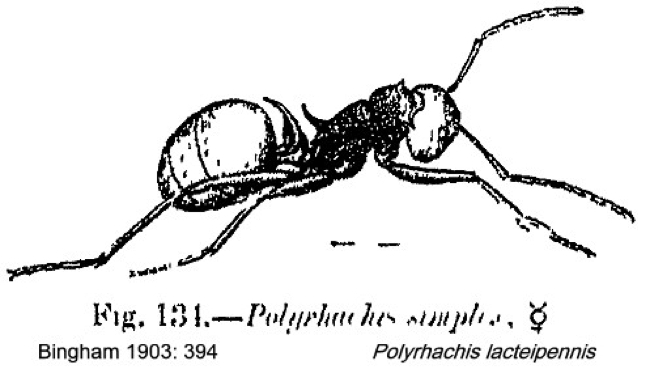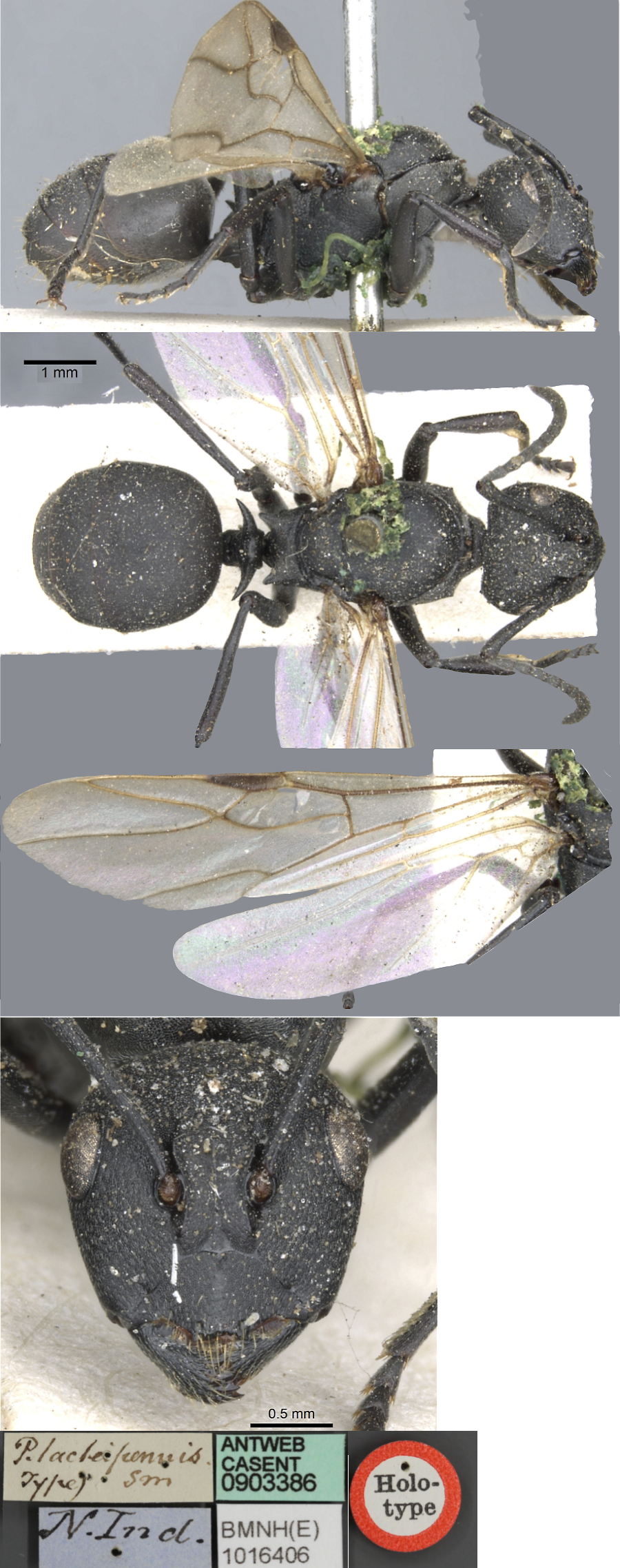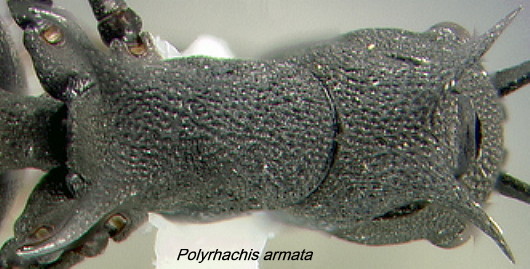Polyrhachis lacteipennis F Smith
  Type location India
(Polyrhachis lacteipennis F
Smith, 1858b: 60, illustrated, queen) Northern India - see below Type location India
(Polyrhachis lacteipennis F
Smith, 1858b: 60, illustrated, queen) Northern India - see below
junior synonym simplex
(Polyrhachis simplex n.
sp., Mayr, 1862: 682, queen) Kashmir - no images on Antweb (July 2014)
and its junior synonyms
obsoleta (Polyrhachis
simples var. obsoleta
n. var., Forel, 1893c: 26, in key, worker) India, Poona, R Wroughton - see http://www.antweb.org/specimenImages.do?code=casent0910897
spiniger (Polyrhachis
spiniger n. sp., Mayr, 1879: 653, worker & male,
synonymy Forel, 1893c: 36) "Ostindien", Rothney (India) -
no images on Antweb (July 2014)
ssp grisescens (Emery, 1895k: 483, worker & queen, synonymy
Bolton, 1974b: 177) from Myanmar [noted only that pubescence
much less sparse giving a grey reflection to the gaster] - see bottom
of this page.
|
  F Smith's
(1858b) description is at F Smith's
(1858b) description is at  . Mayr's (1862) description of simplex
is at . Mayr's (1862) description of simplex
is at  . Mayr's (1879: 653) description of spiniger
is at . Mayr's (1879: 653) description of spiniger
is at  . Forel's (1893c) description is at . Forel's (1893c) description is at  . .
|
 The
photomontage
of the type queen is collated from http://www.antweb.org/specimen.do?name=casent0903386 The
photomontage
of the type queen is collated from http://www.antweb.org/specimen.do?name=casent0903386
|
Note - although F Smith (1858b) stated the petiole (of a
queen) as having the centre of the margin emarginate, his drawing Fig
40 shows the petiole with a pair of short median spines or teeth!
Bingham's (1903) illustration of the worker clearly shows the petiole
as described by Smith, i.e. emarginate medially.
Bingham (1903: 383ff) gave a key to Polyrhachis
from the Indian subcontinent - simplex keys as - alitrunk and
petiole armed with spines or teeth ... pronotum and propodeum with a
spine on each side (mesonotum unarmed) ... propodeum not laterally
margined ... propodeal spines not hooked ...pubescence sparse ...
petiole spines not very wide-spreading (not encircling gaster) ...
generally black ... head, alitrunk and petiole finely punctate ... node
of petiole without median spines ... simplex (p 394). Bingham
does not mention lacteipennis in his very comprehensive text,
even though it appears to be one of the commonest members of the genus
in southern Asia.
The specimens sent to BT from Israel and shown below
would appear to differ significantly from the (poor) descriptions of lacteipennis
from the Indian sub-continent and a fuller analysis could lead to a
separation of the Egypt-Middle East specimens into a distinct species
[BT opinion].
Two further workers from Iran (below) match the
Israel specimens. While looking for Antweb images, I came across
(October 2015) the paper by Dietrich (2004). In that he felt it
justified to designate the Middle East from as a new species, Polyrhachis palaearctica. Antweb do not have images of the
type but the SEM images of the lateral and dorsal alitrunk are a close
fit to those I have. Two factors appear to cast slight doubt on
Dietrich' s findings. First he mentions P. lacteipennis only vaguely. He did not list it as a species and
did not sight the type queen or, apparently, the type of what he refers
to as "Polyrhachis simplex".
The latter he placed as a junior synonym of Polyrhachis spiniger. He separated Polyrhachis grisescens as
a
separate species but the type images (bottom) are little or not
different from the fresh specimens from Israel and Iran. Dietrich
refers to a paper on the ant in Israel by Ofer (1970) but in that the
species was given as P. simplex. So, pro tem, I
leave the findings as under Polyrhachis
lacteipennis.
DIETRICH, C.O. (2004) Taxonomische Beiträge zur
Myrmekofauna Jordaniens (Hymenoptera: Formicidae). Denisia 14, zugleich Kataloge der
OÖ. Landesmuseen Neue Serie 2 (2004), 319-344.
OFER, J. (1970) Polyrhachis simplex the weaver ant of Israel. Insectes Sociaux, 17, 49-82.
|
Egypt records - Wheeler & Mann (1916)
reported it as junior synonym simplex; as spiniger from
Wadi Feran, Sinai Peninsula, nesting on trees and tending Membracids.
Emery (1925b), however, drew attention to Forel (1909e: 402 & 404) where simplex was stated to make a
silk-lined nest in a
subterranean cavity. Attributing the discovery to Wroughton, Forel (p 404) had: Nest of a single compartment (uniloculaire)
with fine, pure, silky tissue, lining a subterranean cavity. Dietrich
(see above) appears to have found reports of Israel populations with
nests in the ground or uncommonly low down on tree trunks.
Menozzi (1929e: 128) reported two queens from Wadi
Scheich and diverse workers from Wadi Feiran, collected in Sinai by F S
Bodenheimer. Also by Finzi (1936) from Wadi Feran, 4.iii.1935.
Mohamad thesis (1979) had - "Polyrhachis viscosa"
- Gebel Elba, 16-26.i.1933 (Coll. Min.) - this probably was an
error for P. lacteipennis, as there is a superficial
similarity, although Polyrhachis
viscosa is easily separated by the alitrunk dorsum having sharp
lateral margination.
The apparent discontinuity in geographical distribution
appears to be bridged by the reports in Collingwood (1985: 274, as simplex)
and Collingwood & Agosti (1996: 375) of findings in Oman, Yemen and
Saudi Arabia. These authors also refer to median petiole spines as
being absent or reduced to tubercles. In neither paper, however, is
there any description of the specimens.
|
 By extracting from Forel's (1893c) key (as simplex)
one gets the following description (from the progressive key couplets) - By extracting from Forel's (1893c) key (as simplex)
one gets the following description (from the progressive key couplets) -
Eyes rounded; alitrunk not bordered, or with solely the propodeum
bordered; scupture accentuated, matt or subopaque, alitrunx spined;
mesonotum unarmed, petiole bispinose; body, at least in part, with
distinct sculpture, matt or subopaque; pronotum with two spines;
metanotal suture indistinct or not visible, often two teeth between the
petiole spines; propodeum not bordered; petiole without hairs, the
spines not recurved apically; propodeal spines not recurved (like the
horns of a chamois) or weakly recurved upwards at their extremities,
head without tubercles (laterally behind the eyes); head and alitrunk
with large reticulations which are weak and more or less effaced
[unlike those on armata], rest finely and densely
reticulo-punctate and matt as on the gaster; pronotum strongly convex
above; alitrunk spines quite short, specially those on the pronotum;
propodeal spines divergent and curved outwards; petiole and gaster as
in P. tubericeps but the spines and specially the dorsal teeth
much shorter; black, matt; pubescence very short and extremely sparse;
almost no erect hairs; TL 4.8-5.8 mm.
Alitrunk of Polyrhachis armata type form -
showing the "gross and deep reticulo-puncturation" referred to in
Forel's key. The photograph is derived from http://stri.discoverlife.org/mp/20q?search=Polyrhachis+armata&guide=Ants_Java.
The species is known from South East Asia.
|
 The photomontage is
of a worker from Israel, Ein
Gedi (Dead Sea Valley), 12.iv.1982, leg J Kugler identified by Prof J
Kugler as lacteipennis, sent to BT by Armin Ionescu. The photomontage is
of a worker from Israel, Ein
Gedi (Dead Sea Valley), 12.iv.1982, leg J Kugler identified by Prof J
Kugler as lacteipennis, sent to BT by Armin Ionescu.
Taking the available information, which is surprisingly
sparse for a reportedly common Indian species, these specimens appear
to be quite distinct from lacteipennis.
Dorow (1995a: ) placed lacteipennis in the dives
species-group, of Subgenus Myrmhopla Forel;  . P. dives from Singapore is
clothed with pale golden pubescence and all the others are from India
south- and eastwards. . P. dives from Singapore is
clothed with pale golden pubescence and all the others are from India
south- and eastwards.
These have a weak but noticeable margination of the
propodeum and seemingly much stronger sculpturation of the the head,
alitrunk and petiole, i.e. more like armata. Structurally they
are more like the members of Dorow's Polyrhachis crypteroceroides
species group but those are all very small, TL 5 mm (these have a TL of
6.25 mm) and have marginate genae, plus a proximally transverse margin
on the first gaster segment.
|
 The photomontage is
of worker from Iran, Fouzieh Heidary (15). The photomontage is
of worker from Iran, Fouzieh Heidary (15).
|
 The photomontage of the Polyrhachis grisescens
type minor worker is collated from http://www.antweb.org/specimenImages.do?name=casent0905639. The photomontage of the Polyrhachis grisescens
type minor worker is collated from http://www.antweb.org/specimenImages.do?name=casent0905639.
|
|